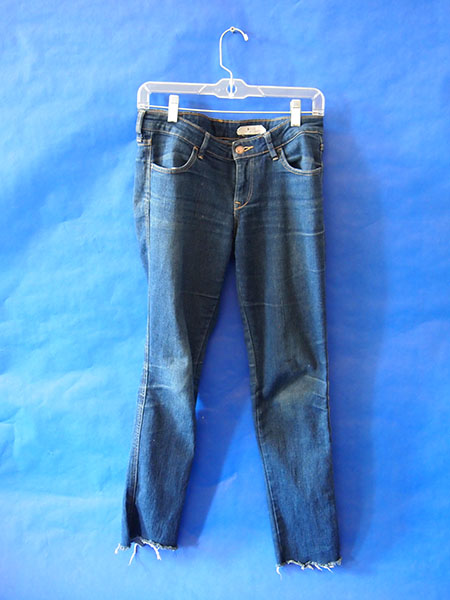![]() body | color | collections | commodity | cube | document | fabric | fetish | gender | glass | home | identity | living | machine | metal | minimal | mobility | narrative | olfactory | organic |
body | color | collections | commodity | cube | document | fabric | fetish | gender | glass | home | identity | living | machine | metal | minimal | mobility | narrative | olfactory | organic |
![]() pain | paper | plastic | plugs | power | protective | rectangular | ritual | round | sound | souvenir | spiritual | style | text-based | time | tool | touch | uniform | value | visual | warm | wood
pain | paper | plastic | plugs | power | protective | rectangular | ritual | round | sound | souvenir | spiritual | style | text-based | time | tool | touch | uniform | value | visual | warm | wood
| Clothing: Blue Jeans with Bottom Seams Trimmed | |||
Narrative: &SQUIN Blue jeans with bottom seams trimmed off, low waist, slim leg, 28x32 Made in Cambodia. Made of 100 percent cotton, including the threads. Synthetic indigo dye is applied to cotton before being woven. Large ball warps are dipped in the indigo mixture so that the dye covers the yarn in layers. Sulfur is used to stabilize the top or bottom layers of indigo dye. The dyed yarn is then coated with sizing to make the threads stronger and stiffer. The yarn is woven on large mechanical looms. Denim cloth is cut into pattern pieces from stacks 100 layers thick with high-speed cutting machines. Sewing is done in assembly-line fashion using human-operated sewing machines. The cloth is brushed to remove loose threads and lint. Byproducts of denim manufacture include organic pollutants, such as starch and dye. Rivets have been traditionally made of copper, but the zippers, snaps and buttons are usually steel or brass. Mina Escondida in Chile is the largest copper producer in the world. Red Dog in Alaska is one of the largest zinc mines. Zinc and copper are used to produce brass buttons. I purchased these jeans in 2010 at H&M in Midtown Manhattan on sale for $10 and cut 2" off of the legs instead of hemming them. I wore them heavily from 2010 through the fall of 2012 when I bought a new pair, so wear these less now. H&M's supply chain consists of Factory Employees, Second-tier Suppliers, Suppliers, Shippers, Auditors, Merchandisers, and Buyers. Cotton is farmed and picked in India, China, and Turkey Clothing design and samples made in Stockholm, Sweden where the headquarters are located. Dying mills and water supply near the Yangtze River in China. Washed and cleaned with water from the Brahmaputra River in Assam. Made and manufactured in Dhaka, Bangladesh; Bangkok, Thailand; Bangalore, Karnataka, India; Bandung, Indonesia; among others. H&M clothing labels and tags are printed in Stockholm, Sweden (approved by the EU Ecolabel Company). Papers are made from Forest Stewardship Council trees (FSC certified). Final products are sent to Hamburg, Germany where they are distributed to store locations. Power generation and supply; Cotton farming; Truck transportation; Oil and gas extraction; Other basic organic chemical manufacturing; Artificial and synthetic fibers and filaments manufacturing; Hosiery and sock mills; Petroleum refineries; Iron and steel mills; Plastics material and resin manufacturing. Water withdraw includes: Cotton farming; Grain farming; Artificial and synthetic fibers and filaments manufacturing; Hosiery and sock mills; Power generation and supply; Fiber, yarn, and thread mills; Other basic organic chemical manufacturing; Paperboard mills; Paint and coating manufacturing; Synthetic dye and pigment manufacturing. |
 |
||
![]()
